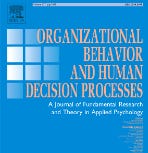New articles in OBHDP (March 20, 2024)
These three articles are part of the special issue on allyship, edited by Ellen Ernst Kossek, Jamie Ladge, Laura Little, Denise Loyd, Catherine Tinsley and Alexis Washington
Beyond allies and recipients: Exploring observers’ allyship emulation in response to leader allyship
https://www.sciencedirect.com/science/article/pii/S0749597823000845
Zhanna Lyubykh, Natalya M. Alonso, Nick Turner
The authors propose that the effectiveness of male leaders’ allyship—leveraging their relative power to help women—may depend on whether male observers react positively to their leaders’ behavior. The authors suggest, and demonstrate across four studies, that observers are more likely to emulate their leaders’ allyship when they identify (feel a sense of “oneness”) with the leader. Importantly, allyship efforts only increased observers’ support for women when they were perceived to be authentic (i.e., “walking the talk”). The authors provide a novel technique—allyship storytelling—that leaders can use to convey that allyship is a prototypical and valued behavior. By telling stories about “regular” employees who engage in allyship, leaders create a stronger personal connection with the listener. These allyship stories also help employees see how they too can contribute to the organizations’ efforts to support women.
Advantaged groups misperceive how allyship will be received
https://www.sciencedirect.com/science/article/pii/S0749597824000013
Hannah J. Birnbaum, Desman Wilson, Adam Waytz
Despite wide-spread acknowledgment that allyship—relatively advantaged group members taking action to support relatively disadvantaged groups—is critical to reducing discrimination, allyship is often rare. This paper suggests that one barrier to allyship may be that advantaged groups underestimate how much disadvantaged groups will appreciate their allyship. The authors propose that this underestimation occurs because advantaged groups are concerned that their efforts will be perceived as inauthentic. In a series of ten studies, the authors found that concerns about inauthenticity and, therefore, underestimation of appreciation, led to lower levels of allyship. The authors provide several recommendations for how organizations can utilize these findings to foster greater support from advantaged groups as they advance their inclusion efforts.
An ally by any other name: Examining the effects of racial minority leaders as allies for advancing racial justice
https://www.sciencedirect.com/science/article/pii/S074959782400013X
McKenzie C. Preston, Terrance L. Boyd, Angelica Leigh, Richard Burgess, Victor Marsh
Leadership roles within organizations impart a sense of advantage that leaders can use to engage in allyship—efforts from relatively advantaged to support relatively disadvantaged groups. Whereas research typically focuses on the allyship potential held by members of a racial majority group, the authors propose that leaders who are members of a racial minority group also have the potential to engage in racial allyship. This allyship can take the form of same-race allyship (advocating for members of their same racial group) or cross-race allyship (advocating for members of a different racial group than themselves). Across three studies, the authors found that leaders were perceived to be more effective allies when they engaged in cross-race allyship versus same-race allyship. This difference was attributed to same-race allyship leading to higher perceptions of ingroup favoritism. The authors provide evidence that this negative consequence of same-race allyship is reduced when allies publicly acknowledge that other employees’ ideas contributed to their allyship. Taken together, these findings outline how racial minority leaders can most effectively engage in allyship.
P.S. if you can’t access the full-text let us (m-kouchaki@kellogg.northwestern.edu or mikebaer@asu.edu) know and we’d be happy to share a copy.


